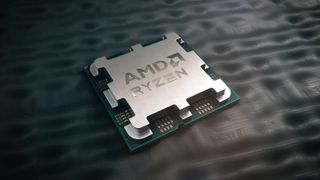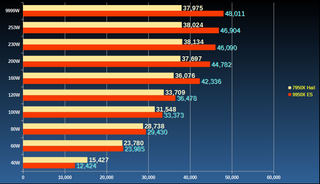AMD's flagship Zen 5 desktop CPU impresses in new rendering benchmarks — Ryzen 9 9950X outperforms Ryzen 9 7950X by 24%
The Ryzen 9 9950X packs a lot of muscle.

AMD's Ryzen 9 9950X, which will compete against the best CPUs, might not be out just yet (arriving July 31st), but that hasn't stopped a PC enthusiast from posting benchmarks of the chip in prototype form. Igor_kavinski posted a gauntlet of Cinebech R23 benchmark runs featuring an engineering sample Ryzen 9 9950X on the AnandTech forums, featuring various power targets to see how efficient AMD's Zen 5 desktop flagship is.
Igor posted ten total benchmark runs of the ES 9950X operating at 40W, 60W, 80W, 100W, 120W, 160W, 200W, 230W, 253W and 9999W. The 16-core Zen 5 flagship posted an impressive 48,011 score at full tilt. That is 24% faster than the Ryzen 9 7950X, which scored a 38,638 result (with PBO) in our review. The Ryzen 9 9950X was also up to 34% faster than the Ryzen 9 7950X3D, which posted a 35,630 score in our review of that chip.
Considering the other power targets, the Ryzen 9 9950X starts hitting a wall beyond the 160W limit, where adding additional power starts to achieve diminishing returns. For example, the jump from 120W to 160W represents a 16% performance improvement, but adding even more power, from 160W to 200W, yields a measly 5% improvement. This trend continues to 9999W, where more power only results in minor performance improvements.

160W appears to be the sweet spot for the Ryzen 9 9950X. Performance improvements are immense, going from 40W all the way to 160W. The double-digit power targets yield the most performance margins. For instance, going from 40W to 60W yields a whopping 51% performance improvement, and going from 60W to 80W yields an even more significant 81% performance improvement.
Igor also bundled his results with another user's results that ran the same power limit configuration in R23 but on the older Ryzen 9 7950X. However, please don't read into the 7950X results too seriously, as the user confirmed they were using air cooling and running into a 95C throttle point, which inevitably is bottlenecking the chip's performance at the higher power targets. The Ryzen 7000 is designed to hit 95 degrees Celsius, but the air cooler is still most likely bottlenecking the chip's performance.
| Power Target: | Ryzen 9 9950X | Ryzen 9 7950X |
|---|---|---|
| 9999W | 48,011 | 37,975 |
| 253W | 46,904 | 38,024 |
| 230W | 46,090 | 38,134 |
| 200W | 44,782 | 37,697 |
| 160W | 42,336 | 36,076 |
| 120W | 36,478 | 33,709 |
| 100W | 33,373 | 31,548 |
| 80W | 29,430 | 28,738 |
| 60W | 23,985 | 23,780 |
| 40W | 12,424 | 15,427 |
Igor's R23 benchmarks give us insight into AMD's decision to keep the 170W power target the same on the Ryzen 9 9950X as the previous generation part. Performance scaling appears to be very similar to the 7950X in that both scale to 160W before both start hitting diminishing returns. The Ryzen 9 9950X is the only chip that retains the same TDP as its predecessor, with the rest of the Ryzen 9000 product stack boasting significantly lower TDPs than their Ryzen 7000 counterparts.
Stay On the Cutting Edge: Get the Tom's Hardware Newsletter
Get Tom's Hardware's best news and in-depth reviews, straight to your inbox.

Aaron Klotz is a contributing writer for Tom’s Hardware, covering news related to computer hardware such as CPUs, and graphics cards.
-
-Fran- I find interesting how at 40W the performance drops a lot compared to Zen4. I'm guessing the improvements to the IF make the overall package consume way more power so the cores can be starved at lower power levels.Reply
And also how AMD realized people was ok with CPUs consuming 250W+ as a norm, so they just upped the power limit. Now, AM5 socket is rated for 250W in motherboards, right? I seem to recall there was an explicit limit to it, but not the exact number.
Regards. -
JamesJones44 The scaling is kind of interesting. 40w watts under performs while is roughly equal between 40w and 100w, after that 9950x runs away with it. Stepping bug in the ES samples?Reply -
eX_Arkangel i think is more a deliberate decision from AMD; based on previous market behavior, the market openly hailed AlderLake++ as the winner (pre degradation fest pandemic breakout decision) even if more often than not needed over twice the power to match or beat Z4, so, they went that road (again), as they already did with Z4, only this time the kinda split the lineups, an obvious choice, going more efficient and expensive node to the segment were perf/w and margins are way larger, and leave DT with cheaper nodes designed for higher speed-voltages. Im assuming that for EPYC Z5 Pcores IF speed will play a bigger perf factor than higher clocks at lower power, if not EPYC Z5 is in for a rough start against GENOA... as this are usually configured for 25~40W per 8Core chiplet (so 50~80W for 2 CCDs), also IMC wont be pushed as hard as in DT speed wise.Reply
Also the 20% speed increase of the IF and cache speed and IMC more likely contributes to lower scores than Z4 at lower power, as the cores starve while the IOD and other parts of the chiplets eat more power for the same work done without directly contributing to the scores/perf at certain powertargets vs workloads.
Edited after fact checking EPYC node use (4NP/X for Z5 Turin P and N3 for Z5C Turin Dense). -
Quirkz I was hoping to see more of an improvement at the lower ~60w TDPs - you know, the laptop targets.Reply
Looks like that while we get very nice desktop improvements, we might not see much in the way of laptop performance. -
TheHerald Reply
I think it's because it's an ES sample. Maybe the VF curve isn't proper yet.-Fran- said:I find interesting how at 40W the performance drops a lot compared to Zen4. I'm guessing the improvements to the IF make the overall package consume way more power so the cores can be starved at lower power levels. -
gamezenchill ReplyFor instance, going from 40W to 60W yields a whopping 51% performance improvement, and going from 60W to 80W yields an even more significant 81% performance improvement.
What's the math ? How are you getting the 51% and 81% performance improvements ? -
Quirkz Reply
I noticed that too.gamezenchill said:What's the math ? How are you getting the 51% and 81% performance improvements ?
29430/23985 = 1.227
so a 23% performance. -
SunMaster It makes the 170W TDP give a lot of sense, and a sensible target, given that there's solid performance increase up to 170W and not so much after. It also makes the 9900x @120W instead of sharing the TDP with the nn50x sibling logical.Reply -
jp7189 I'm really loving AMDs solid and consistent improvements, but now I'm conflicted... my infracaninophile* nature is causing me to root for Intel for the first time I can ever recall.Reply
*I admit, I had to look it up. Infracaninophile = someone who always roots for the underdog. -
Silas Sanchez So the quick math shows that from 200W to the limit, the7950x only yields 1% increase while the 9950x yields 7%. Not interested thanks. Dealing with that much heat on a mobo that sure wasn't designed for it for so little gain, right back to the intel problem. Still if 24% is what i get then that would be worth it. By the looks ~200W is the hard limit for air coolers, at least mine. maybe 220-230max with better designs. Air just cant compete with water.Reply
Most Popular



